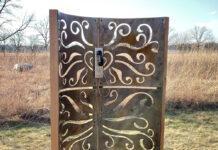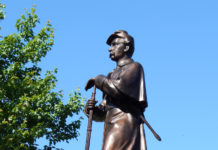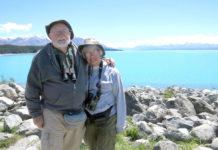In early 2013, Mankato resident and art lover Yvonne Cariveau was pouring her heart into helping organize Mankato’s Walking Sculpture Tour, which had started in 2011 and turned into an annual phenomenon. But as Cariveau helped select and install sculptures into their temporary locations along East Main Street and other locations, she started thinking, Why not organize something similar with other types of art… like poetry?
“I was thinking about poetry because I was in a poetry group,” Cariveau explained. “I wondered if I could do something that was inexpensive [and] expose people to the really cool poets who are in the area. Sculptures are awesome, and I really appreciate them, but I also appreciate written word art.”
According to Cariveau, each sculpture along the art walk cost about $2,000 to obtain and install, meaning the whole event required about $60,000 worth of fundraising every year. She started thinking that a similar walk featuring poetry instead of sculptures must be possible at a lower cost, since she only needed to put words on a sign.
From that small idea bloomed the Mankato Poetry Walk and Ride, which officially started in 2013 and has been going strong for six years.
Starting With the Poets
When Cariveau first dreamed up a poetry walk, she turned in a natural direction: to her fellow poets. She began asking what they would like to see in a poetry walk and how to draw enough poets to create a well-rounded walk. After discussion, she decided to hold a poetry contest with a $6 entrance fee to submit three poems. There would be 40 winners, who would split the entrance fee pile as their prize money. The judges would come from the Southern Minnesota Poets Society, of which Cariveau was a member.
“With the sculpture walk, an important part of its success was communication with the artists,” she said. “So I talked to [the poets] about what worked for them.”
Cariveau also talked with local businesses about sponsoring the event, as well as working with the city of Mankato and North Mankato. While her original plan was to install signs along different nature trails and city paths, Mankato representatives added the idea of including directions on the signs—something that was lacking along the city’s routes at this point. The city also wanted to be in charge of installing the signs, to ensure its trails were taken care of, but it wasn’t sure how to pay for the work. In the end, Cariveau applied for and was granted a community improvement grant for $1,500, which she turned around and gave back to the city so that it could install signs.
I’d love to double the density and have 80 poems in town– Yvonne Cariveau
While Cariveau was envisioning cheap metal signposts, city representatives actually installed composite wood and plastic posts that are sturdy and look attractive. Mankato took care of the signs along its routes, while North Mankato also joined in the effort and installed signs along its trails as well. Cariveau worked with city representatives and area bicycle and pedestrian groups to create a map of the entire Mankato-North Mankato community, figuring out where directional signs were still needed.
“I asked bicyclists, ‘Where are signs needed?’” Cariveau said. “We talked to the city about which location, which side of the street, etc. and planned out where all the signs are now in both communities.”
As for the poets, they came out in droves to participate in Cariveau’s contest, with more than 100 submissions. Categories were broken into youth and adult divisions, as well as serious and humor divisions, and poems were only able to so long because of space concerns. In the end, 42 area poets were selected for the first year.
Growing and Improving
For the first year of the walk, Cariveau and her husband did almost everything, such as installing the signs. To make matters more complicated, North Mankato and Mankato used different signposts, so the signs need to have different holes in order to be installed. The Mayo Clinic Foundation donated $1,800, while Creative Ad Solutions donated free sign printing for three years. Other businesses, such as Key City Bike and the Hilton Garden Inn, also donated.
While Cariveau originally thought that every year would cost about $1,800, she ended up stretching Mayo’s funds for more than three years, with the cost of an entire event totaling about $750. In addition, even after Creative Ad Solutions’ donation ended, the company continued to offer a discount to print the signs.
“For $750, all the expenses are covered,” Cariveau said. “[It costs] $25 for each sign, compared to $2,000 for each sculpture [in the Art Walk], so I think that’s pretty good. And they look really nice.”
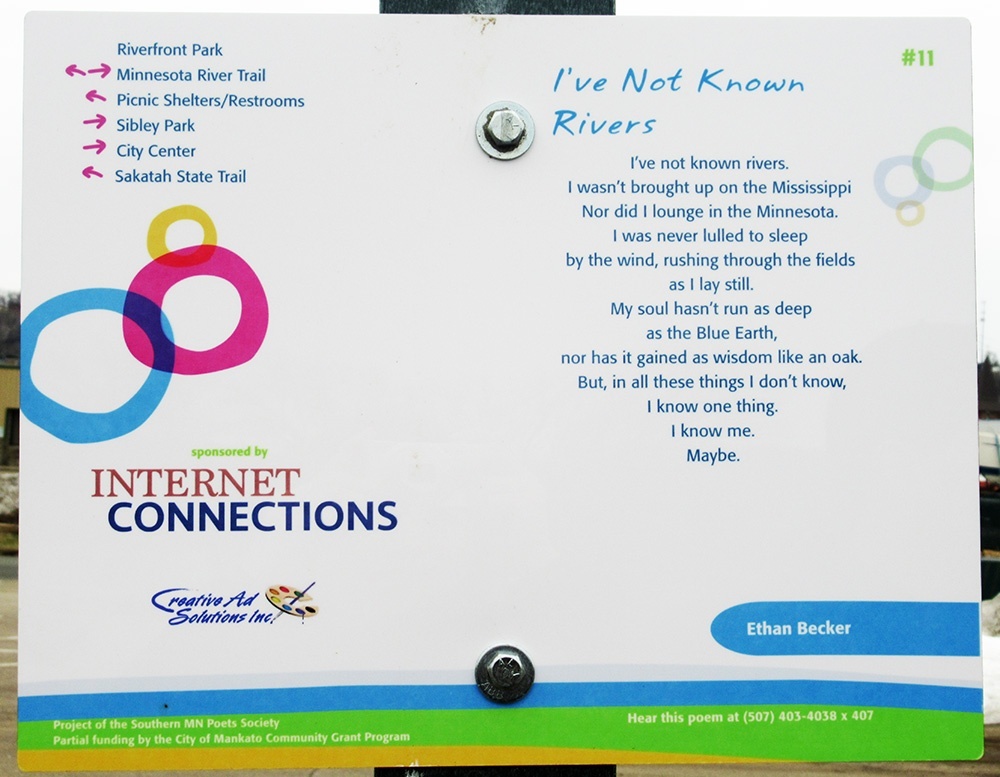
Along the way, Cariveau has expanded her team to several volunteers, made up mostly of the poets who have been featured. She takes an inventory of signs every year, with poets divvying up the area and walking every route to find signs and take pictures. Cariveau looks at the submitted photos and decides which signs need to be replaced.
“Every winter, we lose 2-4 signs to snow plows, vandalism and weird stuff,” she said.
In addition, half of the signs along the route are replaced with new poems after the next round of submissions. Originally, Cariveau replaced all 42 signs, but she said she and her husband quickly realized that wasn’t sustainable.
Throughout the years, a wide variety of area poets have been featured—including Cariveau herself. The youngest poet was seven, while the oldest was 77
“For the first year, it took us three solid days to get to each location, take the old one down, put a new one up, take a photo and document it on the map,” she said. “It ended up being kind of a big project. So, we decided to update half each year.”
Cariveau also eliminated the contest’s entry fee, saying it seemed like it would make things simpler. While the number of submissions dropped in following years, she still received 55 entries for this year’s event, with submissions closing on March 1.
Cariveau said that judging only takes a few weeks, since there aren’t too many poems to review. Around April 1, she knows which poems have been selected, so she’s able to begin the layout process of taking every poem and designing its sign. This process takes about a month, and it includes working with Mankato and North Mankato to see if there have been any changes to the cities’ trails. The new signs are installed sometime in May or June, depending on when volunteers make it out.
“The poets all take a walk and get a set of boards and take down the old one and set up the new ones,” Cariveau said. “They should be up by the early part of the summer so that people can enjoy them in the summertime and into the fall as they’re walking around.”
Throughout the years, a wide variety of area poets have been featured—including Cariveau herself. The youngest poet was seven, while the oldest was 77. Some have been publishing poems for years, while others had never been featured before they were selected.
“We had an older guy who came out meet with me [to go over his poem], and he brought his wife with him,” Cariveau recalled. “He’s a farmer who’s written poems for years, but he’s never really shared them with anybody. Doesn’t share them at poetry events, doesn’t come to poetry things. Just writes poems, quietly, on the side. He submitted one and he got into the walk. He brings his wife to my house, and the pride on his wife’s face… She just said, ‘I had no idea he had this in him. I just think this is really, really cool.’ He was standing tall. And that was really cool, his sense of self-esteem about being a good writer.”
Hopes for the Future
Looking forward, Cariveau said she would like to be able to have a greater density of poems in the Mankato area. Right now, poems are scattered across several miles, which can be a good thing because people can come across them in many areas, but it’s harder to see several at one time.
“Greater density of the poems would be awesome,” she said. “The Sculpture Walk has a high density, so then a person who’s a visitor to the community can come and boom-boom-boom see ten sculptures. We wanted to go a different way. About every half to three-quarters of a mile, if you’re in the Mankato area, you’re going to find one of these poems, in the parks, on the trails. We wanted them to be more spread out, so that they’re in people’s neighborhoods and near their homes. And maybe they only see two or three of them on their daily commute or their usual walk, but it’s also a reason to go and explore a different park or go to a different part of town. If we could, I’d love to double the density and have 80 poems in town, but we don’t have the infrastructure for that.”
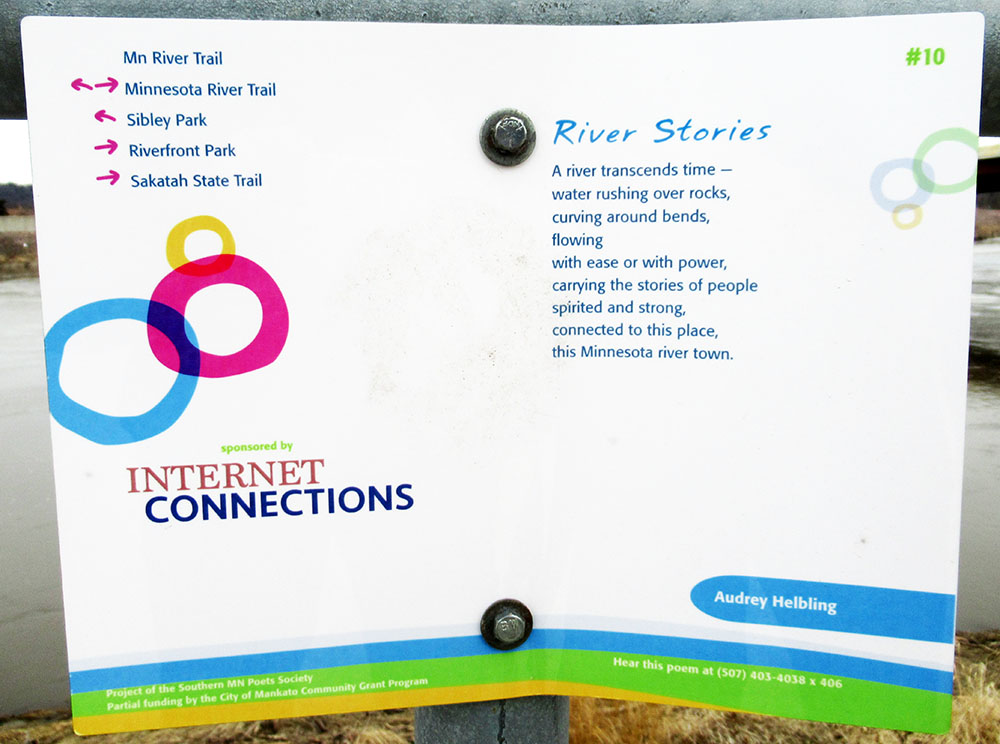
Cariveau said she’d also like to encourage more young people to submit poems. When the project first began, she and other volunteers had more time to visit schools and encourage students to create something to share. However, she said it’s been difficult to find time to make those school visits lately, and not many younger students are submitting anything anymore.
“I’d love to find more help with getting young people to write poems,” she said. “It’s an amazing thing to have a 10-year-old girl stand next to a signpost that has her poem on it and hear her say, ‘I’m a writer.’ This little girl has this idea in her head now that she’s a writer, that she’s a good writer, and she carries that with her. I felt really good about that part of it.”
But Cariveau’s biggest goal is to simply give more poets opportunities to share their work with the community.
“I’d like to grow [the walk] and expand it to reach more poets,” she said. “I think it’s important for the community to see that there’s all different kinds of art; there’s sculpture, there’s writing, there’s dance, there’s music. We have a vibrant art community here. It’s part of why our town is growing the way it’s growing.”
Additional Links
Mankato Poetry Walk and Ride on Facebook
Finding Support
Cariveau’s hope every year is to find a business to sponsor the entire walk. If a business agrees, their logo is prominently featured on each of the 42 signs along the route. And, since only half the signs are changed every year, that means a business is featured for two years.
“It’s a great deal for a business, because your logo is on the sign for two years, and the signs look really nice, even after two years,” Cariveau said. “They don’t seem to really succumb to the sun or the elements. And if somebody comes along and graffitis it, we’ll replace it.”
Last year, Cariveau ended up paying for the entire event herself, since she didn’t have time to go out and find sponsors. But she’s hoping a business will step up this year.
“I already worked two jobs and didn’t have time for a third, so I said, ‘For the time it would take me to do that, I’ll just write the check and call it a day,’” she said. “This year, I’m trying to find sponsors. The good thing is it’s a very inexpensive project.”
An Earlier Attempt
According to Cariveau, there was an earlier attempt to create a poetry walk of sorts around 2011, when the city stamped poems into sidewalks around Old Town Mankato and at Riverfront Park. There was a contest to select poems, and Cariveau was one of the winners. (You can find her “tuna haiku” in front of the former Mary Lue’s Yarn and Ewe location on Riverfront Drive.) However, stamping poems into cement turned out to be much more difficult than anticipated.
“When they pressed [my poem] into the cement, the humidity was too high, so it wasn’t a very good print of the words,” Cariveau said. “They also didn’t put our names on them, which was a little disappointing. It turns out it’s really difficult to print words into a sidewalk and still have it be nice and readable. The humidity has to be just right, the cement has to be just right… So, I was thinking about how hard that was and how expensive that was… and that’s why I was like, ‘Hey, we could put the poems on signs.’ It’s a lot less expensive than printing it in cement.”
The Voices of the Poets
One unique part of the project is how every poem is available in audio format through the city of Mankato’s On Cell system, the same system that is available for people completing the Art Walk. The city of Mankato allows Cariveau to make use of the system at no cost, and people can simply call a number listed on each sign to hear the poems being read. Poets are invited to record themselves reading their poems, but if they don’t want to participate, Cariveau or her husband will read the poems instead.
“We had two 10-year-old girls, and they decided to share intellectual property and put both their names on the poem they wrote together,” she said. “The girls read the poem in sync together, and it was the most adorable thing.”
Following the Map
Early on in the project, Cariveau created a Google map that listed the location of every poem. Throughout the years, she has added as much public art as she can find, including Art Walk sculptures, painted utility boxes and murals. The map shows pictures of every artwork and allows people to take a virtual tour before going out to see the real thing.
“Pretty soon, it was all the outdoor art in Mankato,” she said. “It’s pretty comprehensive now. If you show everything, there’s a ton of free, accessible public art in Mankato, and I only do outdoor stuff. You might see a sculpture, you might see a couple of poems, you might see a mural… If anybody finds [something not listed], send me a note and I’ll add it.”
For more information, visit www.mankatopoetrywalk.com.


